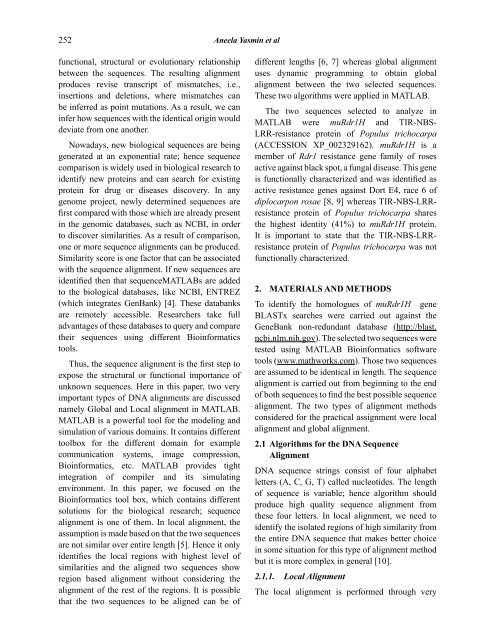Download Full Journal - Pakistan Academy of Sciences
Download Full Journal - Pakistan Academy of Sciences
Download Full Journal - Pakistan Academy of Sciences
Create successful ePaper yourself
Turn your PDF publications into a flip-book with our unique Google optimized e-Paper software.
252 Aneela Yasmin et al<br />
functional, structural or evolutionary relationship<br />
between the sequences. The resulting alignment<br />
produces revise transcript <strong>of</strong> mismatches, i.e.,<br />
insertions and deletions, where mismatches can<br />
be inferred as point mutations. As a result, we can<br />
infer how sequences with the identical origin would<br />
deviate from one another.<br />
Nowadays, new biological sequences are being<br />
generated at an exponential rate; hence sequence<br />
comparison is widely used in biological research to<br />
identify new proteins and can search for existing<br />
protein for drug or diseases discovery. In any<br />
genome project, newly determined sequences are<br />
<br />
in the genomic databases, such as NCBI, in order<br />
to discover similarities. As a result <strong>of</strong> comparison,<br />
one or more sequence alignments can be produced.<br />
Similarity score is one factor that can be associated<br />
with the sequence alignment. If new sequences are<br />
<br />
to the biological databases, like NCBI, ENTREZ<br />
(which integrates GenBank) [4]. These databanks<br />
are remotely accessible. Researchers take full<br />
advantages <strong>of</strong> these databases to query and compare<br />
their sequences using different Bioinformatics<br />
tools.<br />
<br />
expose the structural or functional importance <strong>of</strong><br />
unknown sequences. Here in this paper, two very<br />
important types <strong>of</strong> DNA alignments are discussed<br />
namely Global and Local alignment in MATLAB.<br />
MATLAB is a powerful tool for the modeling and<br />
simulation <strong>of</strong> various domains. It contains different<br />
toolbox for the different domain for example<br />
communication systems, image compression,<br />
Bioinformatics, etc. MATLAB provides tight<br />
integration <strong>of</strong> compiler and its simulating<br />
environment. In this paper, we focused on the<br />
Bioinformatics tool box, which contains different<br />
solutions for the biological research; sequence<br />
alignment is one <strong>of</strong> them. In local alignment, the<br />
assumption is made based on that the two sequences<br />
are not similar over entire length [5]. Hence it only<br />
<br />
similarities and the aligned two sequences show<br />
region based alignment without considering the<br />
alignment <strong>of</strong> the rest <strong>of</strong> the regions. It is possible<br />
that the two sequences to be aligned can be <strong>of</strong><br />
different lengths [6, 7] whereas global alignment<br />
uses dynamic programming to obtain global<br />
alignment between the two selected sequences.<br />
These two algorithms were applied in MATLAB.<br />
The two sequences selected to analyze in<br />
MATLAB were muRdr1H and TIR-NBS-<br />
LRR-resistance protein <strong>of</strong> Populus trichocarpa<br />
(ACCESSION XP_002329162). muRdr1H is a<br />
member <strong>of</strong> Rdr1 resistance gene family <strong>of</strong> roses<br />
active against black spot, a fungal disease. This gene<br />
<br />
active resistance genes against Dort E4, race 6 <strong>of</strong><br />
diplocarpon rosae [8, 9] whereas TIR-NBS-LRRresistance<br />
protein <strong>of</strong> Populus trichocarpa shares<br />
the highest identity (41%) to muRdr1H protein.<br />
It is important to state that the TIR-NBS-LRRresistance<br />
protein <strong>of</strong> Populus trichocarpa was not<br />
functionally characterized.<br />
2. MATERIALS AND METHODS<br />
To identify the homologues <strong>of</strong> muRdr1H gene<br />
BLASTx searches were carried out against the<br />
GeneBank non-redundant database (http://blast.<br />
ncbi.nlm.nih.gov). The selected two sequences were<br />
tested using MATLAB Bioinformatics s<strong>of</strong>tware<br />
tools (www.mathworks.com). Those two sequences<br />
are assumed to be identical in length. The sequence<br />
alignment is carried out from beginning to the end<br />
<br />
alignment. The two types <strong>of</strong> alignment methods<br />
considered for the practical assignment were local<br />
alignment and global alignment.<br />
2.1 Algorithms for the DNA Sequence<br />
Alignment<br />
DNA sequence strings consist <strong>of</strong> four alphabet<br />
letters (A, C, G, T) called nucleotides. The length<br />
<strong>of</strong> sequence is variable; hence algorithm should<br />
produce high quality sequence alignment from<br />
these four letters. In local alignment, we need to<br />
identify the isolated regions <strong>of</strong> high similarity from<br />
the entire DNA sequence that makes better choice<br />
in some situation for this type <strong>of</strong> alignment method<br />
but it is more complex in general [10].<br />
2.1.1. Local Alignment<br />
The local alignment is performed through very

















